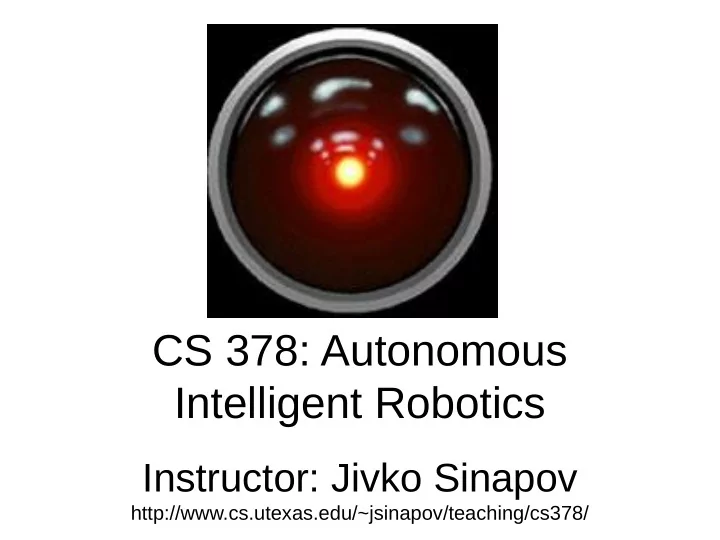

CS 378: Autonomous Intelligent Robotics Instructor: Jivko Sinapov http://www.cs.utexas.edu/~jsinapov/teaching/cs378/
Announcements Volunteers needed for a demo on 2/19 between 10 am and noon. Email me if you are interested in helping out
Announcements FRI Summer Research Fellowships: https://cns.utexas.edu/fri/beyond-the-freshman-lab/fellowships Applications are due March 1 st but apply now! Funding is available for 4-5 students per FRI stream
Announcements Homework 2 is due tonight
Readings for this week Thelen, Esther, et al. "The dynamics of embodiment: A field theory of infant perseverative reaching." Behavioral and brain sciences 24.01 (2001): 1-34. Butko, Nicholas J., and Javier R. Movellan. "Learning to look." Development and Learning (ICDL), 2010 IEEE 9th International Conference on. IEEE, 2010. Hülse, Martin, Sebastian McBride, and Mark Lee. "Developmental robotics architecture for active vision and reaching." Development and learning (ICDL), 2011 IEEE international conference on. Vol. 2. IEEE, 2011.
Progression 2D simulation 2D simulation 3D simulation Real World
Today 1) Behavior-Based Control 2) Subscribing to topics in ROS 3) Representing position and orientation in 3D 4) Homework 3 comes out
Reading Discussion “I would especially like to learn about how growing up in different settings affects learning in different ways. … I am very curious about how growing in a very rural environment— say, the Mongolian steppes — affects learning and development as opposed to growing up in Hong Kong or how growing up in a more impoverished area affects growing up compared to Beverly Hills.”
What should the turtle do? • Move the turtle (forward or backward) • Draw a circle • Add more turtles • Chase something (another turtle?) in the map • Respond to text commands • Control turtle with a mouse
What are some possible behavior primitives? • Go forward/backward a fixed distance • Turn, TurnLeft, TurnRight • KeepPosition • GoToPosition • Circle
What should the turtle sense about the world? • The boundaries of the space • Its own coordinates and orientation (in ROS when you have position + orientation = pose) • Other agents or objects • Color sensor?
Subscribing to ROS topics
Orientation in 2D
Position and Orientation in 3D
Quaternions
Roll – Pitch – Yaw [http://www.chrobotics.com/library/understanding-quaternions]
Roll – Pitch – Yaw
Roll – Pitch – Yaw
Converting between Quaternions and RPY
Homework 3
Traveling Salesman INPUT OUTPUT
Traveling Salesman
Homework 3 • The main task consists of making the turtle visit a set of points in the environment • The behavior needs to be semi-intelligent, i.e., the turtle needs to actively decide which point to visit next • Your program will need to log the total distance traveled by the turtle and the time it took the turtle to visit every point
Example
Homework Brainstorm • How should the problem be broken down? • How can the turtle detect that it has reached a desired position?
THE END
Recommend
More recommend